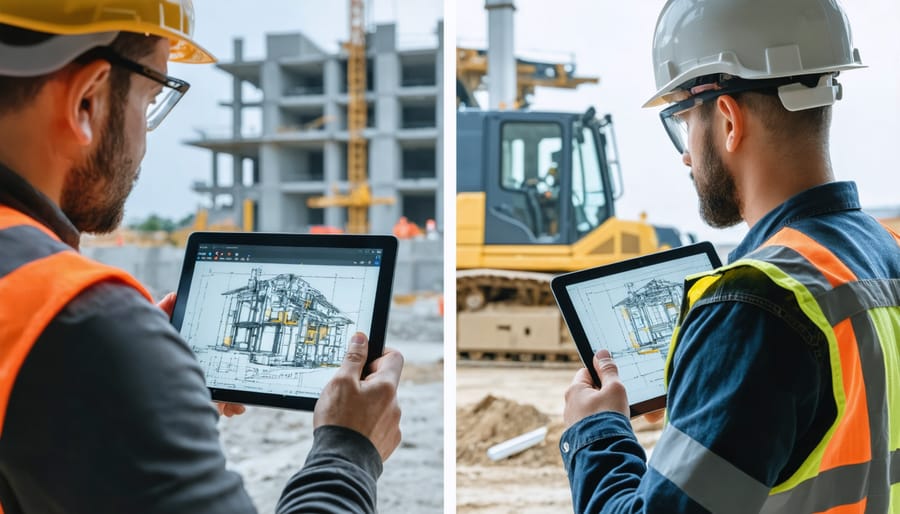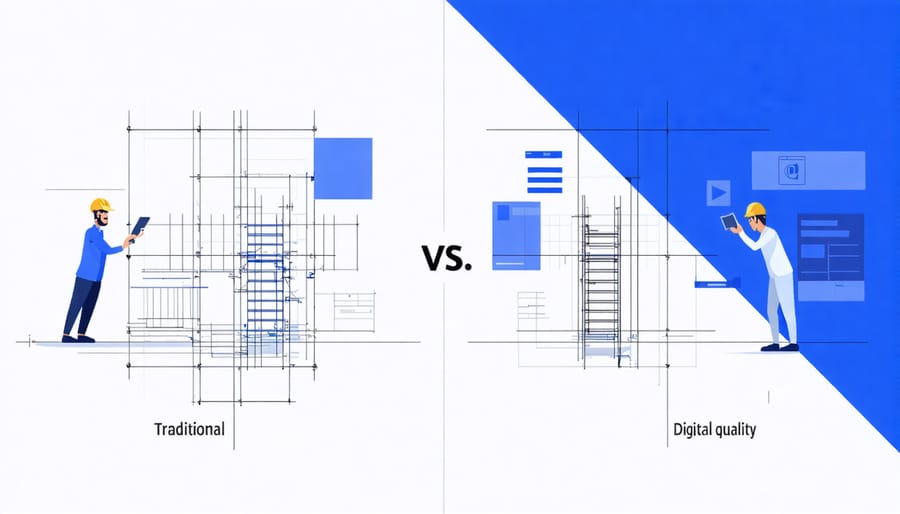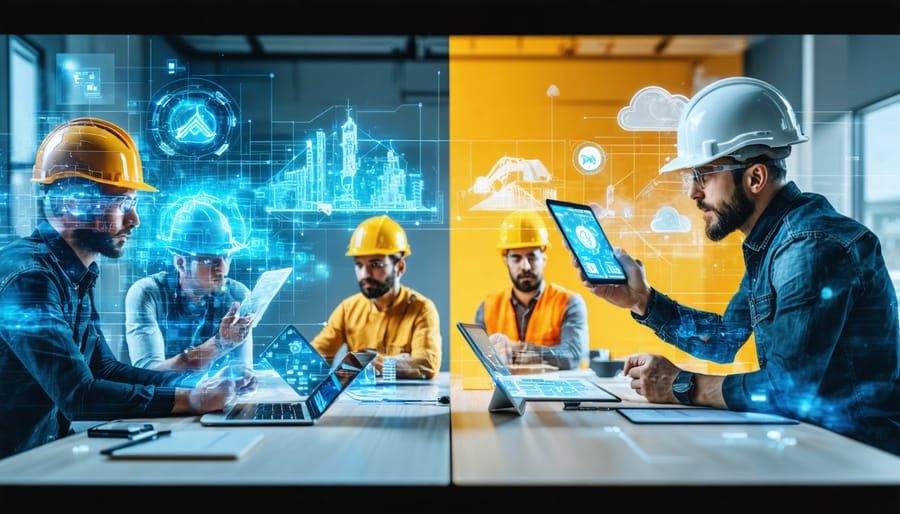Revolutionize construction operations by integrating remote and on-site teams through cloud-based project management platforms, enabling real-time collaboration across multiple locations. Deploy advanced workforce management systems that synchronize scheduling, resource allocation, and performance tracking, dramatically reducing coordination gaps and increasing project efficiency by up to 35%. Implement standardized digital communication protocols across departments, ensuring seamless information flow between field workers, project managers, and office staff while maintaining strict compliance with industry regulations and safety standards.
The construction industry’s rapid digital transformation demands a strategic approach to workforce integration, combining traditional expertise with innovative technologies. As projects become increasingly complex and geographically dispersed, successful companies leverage integrated solutions to connect their entire workforce ecosystem. From BIM coordination meetings to daily toolbox talks, modern integration tools create a cohesive operational environment that drives productivity, ensures safety, and maintains quality standards across all project phases.
This comprehensive guide explores proven strategies, cutting-edge technologies, and best practices for achieving successful workforce integration in today’s dynamic construction landscape, focusing on practical solutions that deliver measurable results.
The Digital Revolution in Construction Management
Key Technologies Driving Remote Integration
The construction industry’s shift toward remote integration is being powered by three key technological pillars. Building Information Modeling (BIM) stands at the forefront, enabling teams to collaborate on detailed 3D models regardless of their physical location. This technology allows for real-time design modifications, clash detection, and comprehensive project visualization, ensuring all stakeholders remain aligned throughout the construction process.
Cloud-based digital construction management systems have revolutionized project coordination and documentation. These platforms provide centralized access to project files, schedules, and communications, enabling seamless information flow between office and field teams. Features like mobile accessibility and automated workflows have significantly improved project efficiency and reduced communication gaps.
Virtual collaboration platforms have become indispensable for remote team coordination. Advanced video conferencing tools, augmented reality (AR) site walks, and virtual meeting spaces allow for meaningful interactions despite physical distances. These platforms often integrate with BIM and project management tools, creating a cohesive digital ecosystem that supports effective remote workforce integration while maintaining high standards of project delivery and team coordination.

Real-Time Communication Solutions
Effective real-time communication forms the backbone of successful remote workforce integration in construction projects. Modern digital platforms have revolutionized how teams coordinate across different locations, enabling seamless collaboration between office staff, field workers, and project stakeholders.
Cloud-based project management solutions with integrated communication features have become essential tools, allowing instant messaging, video conferencing, and document sharing in real-time. These platforms enable quick decision-making and problem-solving, particularly crucial during critical construction phases where delays can impact project timelines and costs.
Mobile applications designed specifically for construction communication have gained prominence, offering features like photo sharing with markup capabilities, voice notes, and location-based updates. These tools ensure that all team members, regardless of their location, maintain consistent communication channels and access to project information.
Video conferencing solutions equipped with augmented reality capabilities have proven invaluable for remote site inspections and technical consultations. This technology allows experts to guide on-site workers through complex procedures while maintaining visual oversight of the work being performed.
To maximize effectiveness, successful implementation requires standardized communication protocols, regular team check-ins, and clear escalation paths for urgent issues. Companies should also ensure redundancy in communication systems to maintain connectivity during network disruptions.
Building Effective Remote Teams in Construction

Remote Team Structure and Roles
In today’s evolving construction landscape, establishing effective modern construction team structures requires careful consideration of roles and responsibilities, particularly in remote settings. Successful remote team integration depends on creating clear hierarchical structures while maintaining flexibility for cross-functional collaboration.
Key positions within remote construction teams typically include:
Project Directors: Oversee multiple projects and maintain strategic alignment across virtual teams
Site Managers: Coordinate on-site activities while liaising with remote team members
BIM Coordinators: Manage digital collaboration and model sharing across distributed teams
Virtual Project Engineers: Handle technical specifications and documentation remotely
Remote Quality Control Specialists: Monitor compliance through digital tools and video inspections
Effective reporting structures in remote settings should establish direct lines of communication while avoiding information silos. This can be achieved through:
– Implementation of digital organizational charts with clear escalation paths
– Regular virtual team meetings with defined participant roles
– Documented communication protocols for different project phases
– Designated point persons for specific technical areas
– Clear delegation of decision-making authority
Organizations should also consider implementing matrix management structures where team members report to both project and functional managers, ensuring proper oversight while maintaining operational efficiency in remote environments.
Training and Skill Development
Effective workforce integration requires a comprehensive approach to training and skill development, particularly when implementing remote work capabilities. Construction professionals must master both traditional construction expertise and digital competencies to succeed in today’s hybrid work environment.
A well-structured digital construction skills training program should encompass several key areas: Building Information Modeling (BIM), project management software proficiency, virtual collaboration tools, and remote communication protocols. These foundational skills enable seamless integration between on-site and remote team members.
Essential technical training components include:
– Cloud-based project management platforms
– Virtual reality (VR) and augmented reality (AR) applications
– Remote monitoring and reporting systems
– Digital documentation and compliance tools
– Cybersecurity awareness and best practices
Equally important are soft skills development programs focusing on:
– Virtual team leadership
– Remote collaboration techniques
– Digital communication etiquette
– Time management in hybrid environments
– Cross-functional team coordination
Organizations should implement structured mentorship programs pairing experienced professionals with newer team members to facilitate knowledge transfer and maintain construction best practices in a remote setting. Regular assessment and certification programs ensure that skills remain current and aligned with evolving industry standards.
Overcoming Remote Integration Challenges
Security and Data Protection
In today’s digitally connected construction environment, protecting sensitive project data and maintaining robust security measures is paramount for successful workforce integration. Construction firms must implement comprehensive security protocols that address both digital and physical vulnerabilities while ensuring seamless collaboration.
Multi-factor authentication (MFA) should be mandatory for all remote access points, particularly when accessing project management platforms and design documents. This additional security layer significantly reduces the risk of unauthorized access and potential data breaches. Companies should also establish encrypted communication channels for sharing sensitive information, including bid documents, client data, and proprietary construction methods.
Regular security audits and penetration testing help identify potential vulnerabilities in the integrated workforce system. These assessments should cover all aspects of the digital infrastructure, from cloud storage solutions to mobile devices used on construction sites.
Data classification protocols are essential for managing different levels of information sensitivity. Project managers should clearly define which data requires restricted access and implement role-based access controls (RBAC) accordingly. This ensures that team members only have access to information necessary for their specific responsibilities.
Employee training on cybersecurity best practices is crucial. Regular sessions should cover topics such as password management, phishing awareness, and secure file sharing protocols. Construction firms should also maintain detailed logs of all system access and file modifications to track potential security incidents and ensure compliance with data protection regulations.
For emergency situations, companies must develop and regularly update their incident response plans, including procedures for data breaches and system outages that could affect workforce integration systems.
Quality Control in Remote Settings
Quality control in remote construction settings demands a sophisticated blend of technology and standardized processes to maintain rigorous construction standards. Remote oversight relies heavily on digital documentation, real-time monitoring systems, and clear communication protocols to ensure project specifications are met consistently.
Advanced imaging technologies, including drone surveys and 360-degree cameras, enable quality control managers to conduct thorough site inspections without physical presence. These tools, combined with Building Information Modeling (BIM) platforms, allow for precise comparison between as-built conditions and design specifications.
Implementation of digital quality control checklists and automated compliance tracking systems helps standardize inspection procedures across remote locations. Mobile applications equipped with geo-tagging capabilities ensure that field reports are accurately documented and instantly shared with stakeholders.
Real-time video conferencing enables expert consultations during critical inspection phases, while IoT sensors monitor environmental conditions, material properties, and structural integrity. This data-driven approach provides objective measurements that support quality assurance decisions.
To maintain effectiveness, successful remote quality control programs typically incorporate:
– Standardized digital documentation protocols
– Regular virtual site walks with project teams
– Automated progress tracking systems
– Clear escalation procedures for quality issues
– Continuous training for field personnel on digital tools
Organizations must establish clear accountability frameworks and decision-making hierarchies to ensure swift resolution of quality concerns, even when key personnel are operating remotely. Regular calibration of monitoring systems and validation of digital measurements remains crucial for maintaining accuracy in remote quality control processes.

Case Study: Successful Remote Integration
In 2021, Turner Construction successfully implemented a remote workforce integration strategy during the construction of the $500 million Metropolitan Healthcare Complex in Denver, Colorado. This case study demonstrates how effective remote integration can enhance project efficiency and collaboration while maintaining high safety and quality standards.
The project team faced initial challenges with coordinating 200+ workers across multiple locations, including on-site personnel, remote design teams, and offshore engineering support. Turner’s solution involved implementing a three-tiered digital infrastructure that seamlessly connected all stakeholders.
At the core of their strategy was the deployment of a unified project management platform that integrated Building Information Modeling (BIM) capabilities with real-time communication tools. Remote team members could access and modify 3D models simultaneously, while on-site workers utilized augmented reality devices to visualize design overlays in real-time.
Key implementation steps included:
– Initial two-week training program for all team members
– Establishment of virtual collaboration protocols
– Installation of high-definition cameras and sensors throughout the construction site
– Creation of dedicated virtual war rooms for crisis management
– Implementation of cloud-based document management systems
The results were impressive:
– 30% reduction in communication-related delays
– 25% improvement in decision-making speed
– 15% decrease in rework costs
– 20% increase in overall project efficiency
Project Manager Sarah Chen notes, “The key to success was our focus on creating a digital ecosystem that felt as natural as face-to-face interaction. We invested heavily in training and change management to ensure everyone was comfortable with the new tools.”
The project also implemented innovative solutions for quality control, with remote inspectors using drone footage and live video feeds to conduct detailed site assessments. This approach not only reduced travel costs but also allowed for more frequent inspections and faster issue resolution.
The success of this integration led Turner to adopt similar strategies across other projects, creating a standardized framework for remote workforce management. The Metropolitan Healthcare Complex project now serves as a blueprint for future large-scale construction projects requiring remote team coordination.
Critical success factors identified include strong leadership support, comprehensive training programs, reliable technology infrastructure, and clear communication protocols. These elements, combined with regular feedback loops and continuous improvement processes, enabled the project to maintain high performance standards while leveraging remote workforce capabilities.
The integration of remote workforce solutions in the construction industry represents a significant shift in how projects are managed and executed. As we’ve explored throughout this analysis, the successful implementation of remote work practices requires a careful balance of technology adoption, cultural transformation, and strategic planning.
The construction sector has demonstrated remarkable resilience and adaptability in embracing remote workforce solutions, particularly in response to recent global challenges. The evidence shows that companies that have successfully integrated remote capabilities have experienced improved project coordination, reduced operational costs, and enhanced collaboration across geographically dispersed teams.
Looking ahead, several key trends will likely shape the future of remote workforce integration in construction. Advanced technologies such as artificial intelligence, augmented reality, and IoT sensors will continue to evolve, offering even more sophisticated solutions for remote project management and oversight. The increasing sophistication of Building Information Modeling (BIM) platforms will further facilitate remote collaboration and decision-making processes.
However, organizations must remain mindful of the challenges that persist. Cybersecurity concerns, technology infrastructure requirements, and the need for ongoing training and support will continue to demand attention and resources. Success in remote workforce integration will depend on maintaining a balanced approach that preserves the hands-on aspects of construction while leveraging digital capabilities to enhance efficiency and productivity.
The future outlook for remote workforce integration in construction appears promising, with emerging technologies and improved connectivity solutions paving the way for more flexible and efficient work arrangements. Companies that invest in robust remote work infrastructure while addressing potential challenges will be better positioned to attract top talent, improve project outcomes, and maintain competitive advantages in an increasingly digital construction landscape.
For construction organizations considering or expanding their remote workforce capabilities, the key to success lies in developing comprehensive strategies that address both technical and human factors while maintaining focus on project delivery excellence and team collaboration.

